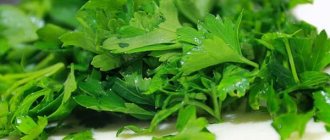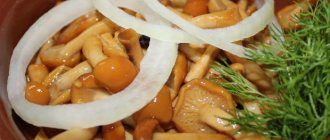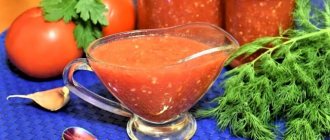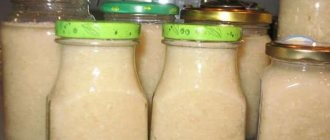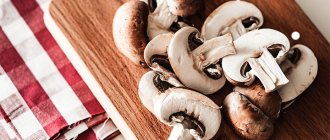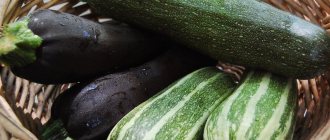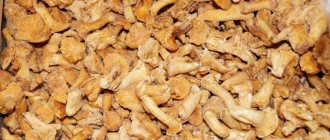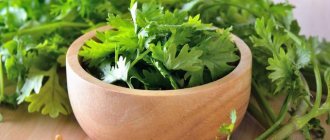If you love spicy snacks, then you’ve probably already rolled up your mother-in-law’s tongue from zucchini for the winter and made other preparations. In order to add a piquant taste to the dish at any time, you should have an ingredient such as horseradish in stock.
It can be prepared in various ways. I have selected several recipes for you, in which we will consider all possible options for preserving the root for the winter.
Even an inexperienced housewife can handle the cooking process if she follows the step-by-step recipes, which are accompanied by photos. If necessary, you can change the composition of the products, since various ingredients are added to the sauce that affect the taste. Therefore, it all depends on individual preferences.
The root does not need to be prepared in any special way. It is enough to peel it and rinse thoroughly.
So, let's look at a few simple preparation options.
Horseradish for the winter: a very tasty and simple recipe without cooking
To prepare the root for culinary purposes, no skill or experience is required. You will need a minimum of time and effort. Therefore, you should not be afraid that you will not be able to cook it.
Ingredients:
- 130 g horseradish;
- 2 tsp 9% table vinegar;
- ½ tsp table salt;
- 1 tsp white sugar;
- 200 ml water.
Preparation
First, the root needs to be cleared of the top layer. This should be done with gloves to avoid burns. Then we wash it, cut it into small pieces and put it in a blender.
Add all the specified ingredients and boiled chilled water to it. Grind for one minute at maximum speed.
We send the ground mass into a clean and sterile jar. Screw on the metal lid.
Store in a cool place. This appetizer perfectly complements baked fish, meat, and salads.
Popular varieties of horseradish
Despite the fact that there are several excellent varieties of horseradish in Russia, semi-wild or wild horseradish grows in almost every garden. Some grow horseradish of Polish selection, but many consider it not vigorous enough.
kan74FORUMHOUSE Member
Polish horseradish is bad, too sweet.
A FORUMHOUSE participant has compiled a list of varieties that are grown by true lovers of this crop.
Suzdal - this variety of Vladimir selection has only good reviews. Valkovsky is a late-ripening variety, dug up 200 days after planting; when grown annually, the rhizome reaches 3 cm in diameter. Resistant to flea beetles. Tatar - this variety is grown in the southern regions. Tolpukhovsky - common in Central Russia. This is a late-ripening variety, the rhizome is large, weighing up to 250 grams. Atlant is a mid-season variety, can be dug at 85-120 days of average size. Alpo is a variety of Polish selection, a medium-sized rhizome with bright white pulp. Malinsky is a variety of Czech selection.
How to keep horseradish fresh for the winter, whole in the refrigerator
If you don't have the time or desire to jar the spicy ingredient. Then you can save it with whole roots. And when you need it, use it to add to cold or meat dishes.
First, you need to clean the roots from the soil, rinse them under cool water and wait until they are completely dry. Place horseradish in 10 pieces, 30 cm long, in plastic bags. Cling film will also work. We make several holes in the packaging and place it in the vegetable compartment in the refrigerator. This method allows you to store the product for one month.
But there is an option that allows you to increase the shelf life to three months. To do this, the roots should be placed in an airtight plastic container.
If you peel the product, it will no longer be suitable for consumption within a couple of weeks.
Storing whole roots in the vegetable compartment of the refrigerator
If you don’t have an equipped storage facility, you can put the horseradish in the refrigerator. The temperature and humidity conditions in the vegetable compartment are suitable for storing small crops.
How to store horseradish in the refrigerator? There are two ways:
- Wash the roots thoroughly and dry on a paper towel. After drying, place the roots in a plastic bag and seal tightly. You can use an airtight food container. The freshness of the crop will remain for 8-10 weeks.
- Wrap the unwashed roots, cleared of soil, one at a time, in cling film. Make several ventilation holes, put it on the vegetable shelf. The shelf life will be about 5 months.
When removing seasonings for cooking, inspect them for spoilage. Towards the end of the shelf life, use the spice for preparations.
Do you know that…
When rubbing horseradish, the space is disinfected. Horseradish phytoncides, scattering throughout the room, kill malicious pathogenic microflora, so it is better to prepare an aromatic seasoning during the approaching epidemics of acute respiratory infections.
Classic recipe for horseradish with beets at home
Men especially like this winter seasoning. If family members do not have any stomach problems and they like dishes with a spicy taste, then be sure to prepare this seasoning.
Ingredients:
- 130 g horseradish;
- 1 beet head;
- 1 tsp sugar;
- ½ tsp salt;
- 2 tbsp 9% vinegar.
Preparation
Peel the roots and cut into medium-sized pieces.
If horseradish has lost its freshness, you can restore its juiciness by soaking it in cold water for one day.
Now you need to twist the root through a meat grinder. To protect your eyes, we attach bags to the spinneret. Close the package and put it away for a while.
We grind fresh beets through a meat grinder, and then squeeze out the juice through cheesecloth. If it turns out to be less than 200 ml, then add a little water.
Add all the specified ingredients to the juice and mix it with chopped horseradish root.
We transfer the spicy snack to a jar, which must first be sterilized. Screw on the boiled lids.
We send the workpiece to the refrigerator or cool cellar. Bon appetit!
Vitamins and nutrients
The root does not have too many calories (100 grams - only 48 kcal!), but it will provide your body with a real wealth of vitamins (vitamin A, B vitamins (vitamins B1, B2, B3, B6 and B9), vitamins C, E and K) and minerals (zinc, phosphorus, magnesium, potassium, sodium, calcium, iron).
It is also interesting that this plant contains twice as much ascorbic acid as lemon (it contains as much as 117 mg of acid). Sulfur compounds are responsible for the pungent taste of the root, thanks to which it has powerful bactericidal and antifungal properties, and also supports the immune system.
This plant not only stimulates the appetite, but also warms the body, increases blood pressure and, according to many experts, is also an effective aphrodisiac. However, do not forget that overdoing it with the amount of horseradish you consume can be harmful to the body. Particular caution in this regard should be taken by people with thyroid diseases, stomach ulcers, diseases of the digestive system and kidneys.
How to preserve pureed horseradish without additives
If you want the roots not to lose their taste and pungency, then it should be prepared for the winter without adding any spices or preservatives.
We clean the roots and rinse them with cold water, place them on a towel until completely dry. Then cut into small pieces to make it easier to chop.
Place the horseradish in a blender and grind. We should end up with a mass that resembles gruel.
Distribute the resulting mass into plastic bags. If desired, add specific amounts of horseradish to make it easier to use during cooking.
Place the filled bags in the freezer for storage.
The product prepared in this way can be stored until late spring. At the same time, vitamins and nutrients are preserved.
Drying horseradish roots
Some housewives prefer to use dried seasonings. They don't take up much space and retain the aroma. But the typical pungency and beneficial properties will be partially lost during heat treatment.
Before drying horseradish, the root vegetables need to be washed as quickly as possible so that they do not have time to absorb water, and then chopped in any way - circles, strips, small cubes.
You can dry it:
- on open air;
- in the oven;
- in an electric dryer.
Drying time depends on the thickness of the slices. Temperature range 40-60 °C. If drying in the oven, keep the door ajar.
The seasoning is ideal for seasoning soups. Stored for up to 2 years in a closed glass jar to prevent moisture penetration. If you want to get a sauce like mustard, add water to the powder, and after swelling, add spices and vinegar.
Tip of the day
It is better not to use grated horseradish for drying due to its pungent odor. Grind the root vegetable after drying using a coffee grinder.
How to prepare horseradish for the winter in a jar without vinegar
Consider a traditional recipe for making spicy seasoning. We will use beets as the second main ingredient. But it is needed not to improve taste, but for color.
Ingredients:
- 500 g horseradish root;
- 150 g boiled beets;
- Table salt according to preference.
Preparation
Remove the top layer from the roots and be sure to rinse with cold water. If the horseradish is soft, then soak it for 12-24 hours.
To protect the mucous membrane of the eyes from horseradish, we put a plastic bag over a meat grinder and twist the roots, preferably twice. You can use a blender for the same purposes.
Grind the boiled beets on a fine grater and mix with the horseradish mixture. Salt to taste and distribute into dry and sterile jars.
We put it in the refrigerator or cellar. This preserve can be used to make hot sauces or add directly to dishes.
Recipe with mayonnaise
Next, we’ll look at how to prepare horseradish seasoning for the winter with the addition of mayonnaise. This sauce creates a rich and savory condiment. It should be noted that the calorie content of the workpiece increases.
Ingredients:
- Mayonnaise – 380 ml.
- Vinegar – 30 ml.
- Horseradish roots – 1/5 kg.
- Granulated sugar – 20 g.
- Salt - to taste.
Preparation:
- Wash the roots, peel them, and puree them in a blender.
- Combine the mixture with mayonnaise, add vinegar, salt, and sugar.
- Place the seasoning in a sterile container and seal tightly.
NOTE: It is recommended to use homemade mayonnaise.
Now you know how to prepare horseradish with mayonnaise for the winter. This preparation has a pleasant delicate consistency. The disadvantage is the short shelf life.
I would like to note that housewives often ask the question of how to prepare horseradish root for the winter . Especially if there are big fans of hot spices in the family. And this seasoning is good with trout and cutlet.
How to preserve horseradish so it doesn't go sour
The savory snack can be stored for a long time if you use only high-quality products. It is also necessary to sterilize the workpiece in boiling water.
Ingredients:
- 1 kg horseradish;
- 30 g salt;
- 30 g granulated sugar;
- 1 glass of 9% table vinegar;
- 2 glasses of water.
Preparation
Peel the roots using a knife or vegetable peeler. Then rinse with cold water.
To make the marinade, you need to boil water, add salt and sugar to it. Mix everything and immediately remove from the burner. After this, pour in the required amount of vinegar.
We must sterilize glass jars and metal lids using any usual method.
Grind the horseradish on a grater. To protect your skin and eyes, use gloves, a mask and goggles.
Pour the grated roots with brine and stir until smooth.
Distribute the hot seasoning into prepared glass jars.
To prevent the workpiece from turning sour after a few days, it must be sterilized for 20 minutes in a pan of boiling water.
After this, screw the lids on the jars. When the snack has cooled, put it in a cool place.
What can you cook from frozen horseradish?
From the frozen root at home you can prepare savory dishes, savory snacks, hot seasonings, hot sauces using the classic recipe with fresh horseradish.
Frozen root, horseradish, which has been frozen in the freezer for a long time, releases fewer phytocides (fewer tears from working with the roots), but retains its burning properties.
Frozen horseradish does not need to be thawed before preparing a fresh batch of sauce, otherwise it will be problematic to grate. The frozen root is easily grated, there is no hassle or tears with it.
How to preserve horseradish from autumn to spring so that it does not fizzle out
To prevent the seasoning from eroding and retaining its beneficial, nutritional properties, it should be stored dry. That is, we subject the roots to heat treatment.
To do this, perform the following steps:
- We thoroughly wash the root vegetables and cut them into thin slices;
- Place parchment paper on a baking sheet and distribute the horseradish;
- Dry the roots in the oven at 50 degrees;
- At the next stage, grind the product in a coffee grinder.
If you store ground dried horseradish in a plastic or glass container, it will not expire not only until spring, but for two years.
How to store in a cellar, basement
The best way to preserve the freshness, benefits and pungency of aromatic roots is to store them in a cellar or basement. The storage should be pre-prepared by disinfecting the shelves and walls with a solution of bleach, copper sulfate or sulfur bomb.
Optimal storage conditions in the cellar:
- humidity 85-90%;
- good ventilation;
- temperature background 0-2 °C.
Wooden boxes and clean, damp sand, perlite or vermiculite are suitable for storing horseradish in the cellar (see “5 reasons to use perlite and vermiculite for winter storage of vegetables, fruits, rhizomes, tubers and bulbs”):
- Place a layer of filler at the bottom of the container.
- Form the next layer from selected unwashed roots, which need to be laid out at some distance from each other.
- Fill the box in layers so that the filler is on top.
The roots will remain fresh for 10-12 months, just periodically inspect them to remove spoiled specimens and moisten the substrate with a spray bottle once a week.
If a box is not found, you can similarly form a pyramid directly on the floor of the cellar. Also, an alternative to boxes is a bucket filled with garden soil. The soil should be slightly moistened and the roots should be buried at a distance from each other. The storage technology is identical.
Tip of the day
Place the fragrant roots in the same box with the carrots. Phytoncides will protect carrots from spoilage.
How to prepare horseradish for the winter through a meat grinder at home
If you and your loved ones do not have problems with the gastrointestinal tract, then horseradish seasoning is perfect for fish or meat dishes. So be sure to roll up a few jars.
Ingredients:
- 600 g horseradish root;
- 300 ml water;
- 50 ml 9% table vinegar;
- 1 tbsp granulated sugar;
- 1 tbsp table salt.
Preparation
Be sure to peel the roots, wash them and pass them through a meat grinder. The vapors from this product are harmful to the eyes, so it is recommended to attach a plastic bag to the die.
To prepare the brine, dissolve sugar and salt in 200 ml of hot water. The liquid must have a temperature of 80 degrees so that the crystals quickly dissolve. Pour the marinade over the chopped horseradish, add vinegar and a little more water to make a liquid paste.
Mix the mixture and transfer it to sterilized jars. Close with nylon lids.
It is best to store the spicy seasoning in the refrigerator, so it can stand for a long time without losing its taste and beneficial qualities.
Pickled horseradish without sterilization
Horseradish with tomato paste is prepared easier and faster than the classic preparation with fresh ripe tomatoes. Natural tomato paste 25% without starch is ideal for preparing homemade horseradish for the winter.
Compound:
- tomato paste – 400 g;
- horseradish roots - 1 kg;
- bell pepper – 0.5 kg;
- hot hot pepper – 200 g;
- vegetable oil – 200 g;
- sugar – 1 glass;
- salt – 1 tbsp. l.;
- vinegar 9% – 100 g.
Cooking method:
- We peel the roots and peppers, pass the vegetables through a meat grinder.
- Mix chopped vegetable pulp with tomato paste. Cook the mixture for 10 minutes.
- Add the remaining ingredients and simmer for a couple more minutes.
- Place the seasoning in sterilized jars and seal with metal lids.
Is it possible to freeze horseradish in the freezer with whole roots to preserve the vitamins?
In winter, the roots can be stored frozen. At the same time, it does not lose its sharpness, healing properties and does not run out of steam. To do this, it is important to know some nuances.
To begin, the roots need to be soaked in cold water for 2-3 hours. Then we clear them of the top layer and immediately place them in a basin of water so that it does not fizzle out and does not irritate the eyes so much.
Make sure to dry the horseradish. Place the product tightly in bags or plastic containers. Place in the freezer. In this form it can be stored for one year.
Horseradish is good for the body
Those who have ever sniffed grated horseradish know that it can easily eliminate the most severe nasal congestion. But this is not the only positive quality of this spicy plant.
- Digestion. Eating horseradish in moderation helps activate the gastrointestinal tract and secrete enzymes. Therefore, it is recommended for use by those who experience difficulties with appetite and weight loss.
Attention! Doctors strictly do not recommend eating horseradish for people who complain of increased stomach acidity, gastritis or peptic ulcers.
- Liver and kidneys. Horseradish has powerful diuretic and choleretic properties. At the same time, there are no restrictions on the use of the root for liver or kidney diseases, which many other spicy dishes cannot boast of.
- Joints. Horseradish normalizes water balance, which has an extremely beneficial effect on the treatment of inflammation of joints and ligaments, gout, and rheumatism.
- Immunity. Thanks to the rich composition of horseradish, it helps the immune system fight viruses and germs.
Preparing the main ingredient
When choosing a root, you need to pay attention to the following points:
- The thickness of the spine must be at least 1 centimeter.
- Color – light, dark brown.
- If the integrity of the shell is broken, a horseradish aroma should appear.
- The length of the spine is 25-30 centimeters.
- White flesh when cut.
The rhizome should be fleshy, dry, elastic, clean, free of mold and mildew. The essential oil quickly evaporates, leaving only bitterness in the horseradish. When using the root of the plant in canning, the peculiar aroma is preserved under tightly sealed conditions.
The leaves do not have such a pronounced aroma and have a milder taste.
Roots exposed to air quickly lose moisture and are difficult to process. Before you start grinding them, you need to place them in a container with fresh cold water. Before this, the rhizomes are washed under running water and cleared of the covering jacket.
The soaking time depends on the freshness of the horseradish:
- for up to 24 hours, 10-20 minutes is enough;
- at 2-3 days it will take up to an hour;
- for a very dried root - up to 24 hours.
The caustic root is crushed during harvesting. This can be done manually (using a grater) or mechanically (using a blender, meat grinder, food processor). The acrid fumes released make processing horseradish unpleasant, especially when using a grater. Essential oils cause lacrimation and irritation in the nasopharynx. The juice can cause chemical burns on your hands.
It is not recommended to grate horseradish in large quantities. You will have to work using protective equipment: gloves, goggles, respirator. The aroma of horseradish will permeate the kitchen space; it will not be possible to dispel this spirit right away. When grinding through a meat grinder, a plastic bag is secured at the outlet, which reduces evaporation. Using a blender with a closed bowl keeps the release of essential oil into the air to a minimum.
After grinding, the prepared horseradish is stored in a glass container with a tight-fitting lid.
All components for canning must be mixed with horseradish in a short time. The longer the horseradish sits open, the more it will lose its pungency. For the same reason, there is no need to prepare horseradish in large quantities and in containers larger than 500 milliliters. The optimal container volume is 50, 100, 200 milliliters, in order to use up the product within 2-3 days.
Use only glass containers for storage. The smell of horseradish will remain on the lids (metal, plastic) and glass; subsequently, you will not be able to use this dish for other purposes.
See also
20 delicious recipes for preparing cabbage preparations in jars for the winter
Read
